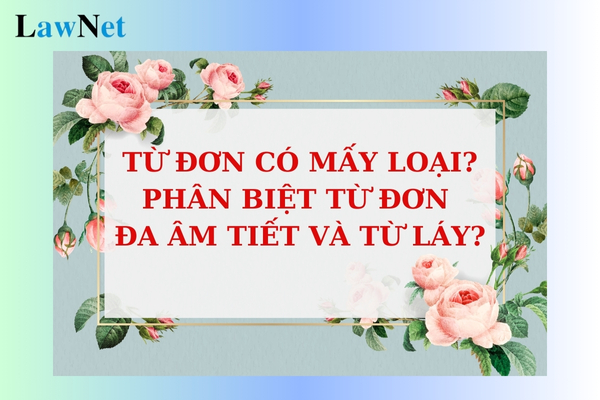What are types of monosyllable in Vietnamese? How to distinguish polysyllabic words and reduplicative words? When do students in Vietnam learn about monosyllable according to Literature curriculum?
What are types of monosyllable in Vietnamese? How to distinguish polysyllabic words and reduplicative words?
Monosyllables are those composed of one syllable or one sound. The components that form a monosyllable have a specific meaning.
Classification of monosyllables:
In Vietnamese, monosyllables are divided into two types: monosyllabic monosyllables and multi-syllabic monosyllables.
- Monosyllabic monosyllables are words formed from just one sound or syllable with meaning. This is the simplest type of word, both in terms of structure and meaning.
+ Example: học, ngồi, ăn, chơi, sách,...
- Multi-syllabic monosyllables are those composed of two or more syllables. A syllable is a unit of sound in language, including a vowel, and may or may not have accompanying consonants. Types of multi-syllabic monosyllables can include phonetically transcribed foreign names, with each syllable separated by a “-“. Or names of objects combined from two sounds without combined meaning.
+ Example: multi-syllabic monosyllables combined from two sounds without meaning: bồ kết, chôm chôm, bồ hóng, châu chấu...
+ Example: multi-syllabic monosyllables in foreign phonetics: ti-vi, in-tơ-nét, ra-đa...
Differentiating multi-syllabic monosyllables and reduplicated words:
- Reduplicated words are complex words in which the sounds repeat entirely or partially, creating different nuances in sound and meaning.
- Essentially, reduplicated words have expressive value, whereas multi-syllabic monosyllables are nouns referring to objects combined from two sounds without combined meaning and do not have expressive value.
+ Example: Words like "ba ba, thuồng luồng, châu chấu" are multi-syllabic monosyllables, though they appear to have identical initial sounds and rhymes, they are not reduplicated words.

What are types of monosyllable in Vietnamese? How to distinguish polysyllabic words and reduplicative words? When do students in Vietnam learn about monosyllable according to Literature curriculum? (Image from Internet)
When do students in Vietnam learn about monosyllable according to Literature curriculum?
Based on Section V of the General Education Program for Literature as issued in Circular 32/2018/TT-BGDDT, the Vietnamese language knowledge curriculum for grade 6 literature includes:
- Single and compound words, compound and reduplicated words
- Multimeaning words and homonyms
- Meanings of some common idioms
- Meanings of some common Sino-Vietnamese elements (e.g., bat, phi) and meanings of the words containing those elements (e.g., bat cong, bat dong, phi nghia, phi li)
- Main components of sentences: expanding the main components of sentences with phrases
- Adverbials: characteristics and function of linking sentences
- Use of the semicolon (marking boundaries in a complex list series); quotation marks (marking the understanding of a word in a non-usual sense)
- Rhetoric of metaphor, metonymy: features and effects
- Paragraphs and texts: characteristics and functions
- Selection of words and some sentence structures appropriate for conveying the meaning of texts
- Text types and genres
+ Narrative texts: essays retelling personal experiences, essays retelling folk tales
+ Descriptive texts: essays describing daily scenes
+ Expressive texts: poems in Luc bat style; paragraphs capturing emotions after reading a Luc bat poem
+ Argumentative texts: opinions, reasoning, evidence; essays presenting viewpoints on a phenomenon in study and life
+ Informative texts: titles, leads, headings, bold text, serial numbers, and bullet points; explanatory texts recounting an event; minutes documenting a case or a meeting, discussion
- Language development: the phenomenon of borrowing words, borrowed words, use of borrowed words
- Non-verbal communication means: images, statistics
According to the above regulations, monosyllables will be taught in the literature curriculum in grade 6.
How many end-of-year commendation titles are there for grade 6 students in Vietnam?
Based on Article 15 of Circular 22/2021/TT-BGDDT, the criteria for commendations are as follows:
Commendations
- The principal awards commendation certificates to students
a) End-of-year commendation
- The title "Excellent Student" is awarded to those with year-long training results rated Good, year-long academic results rated Good, and at least six subjects assessed with a combination of commentary and numerical evaluation having an average score of 9.0 or above.
- The title "Good Student" is awarded to those with year-long training results rated Good and year-long academic results rated Good.
b) Commendations for students with notable achievements in training and study during the academic year.
- Students with special achievements are reviewed and proposed by the school for higher-level commendations.
According to the above provisions, there are two end-of-year commendation titles available for grade 6 students:
- The title "Excellent Student" for those with year-long training results rated Good, year-long academic results rated Good, and at least six subjects assessed with a combination of commentary and numerical evaluation having an average score of 9.0 or above.
- The title "Good Student" for those with year-long training results rated Good and year-long academic results rated Good.

